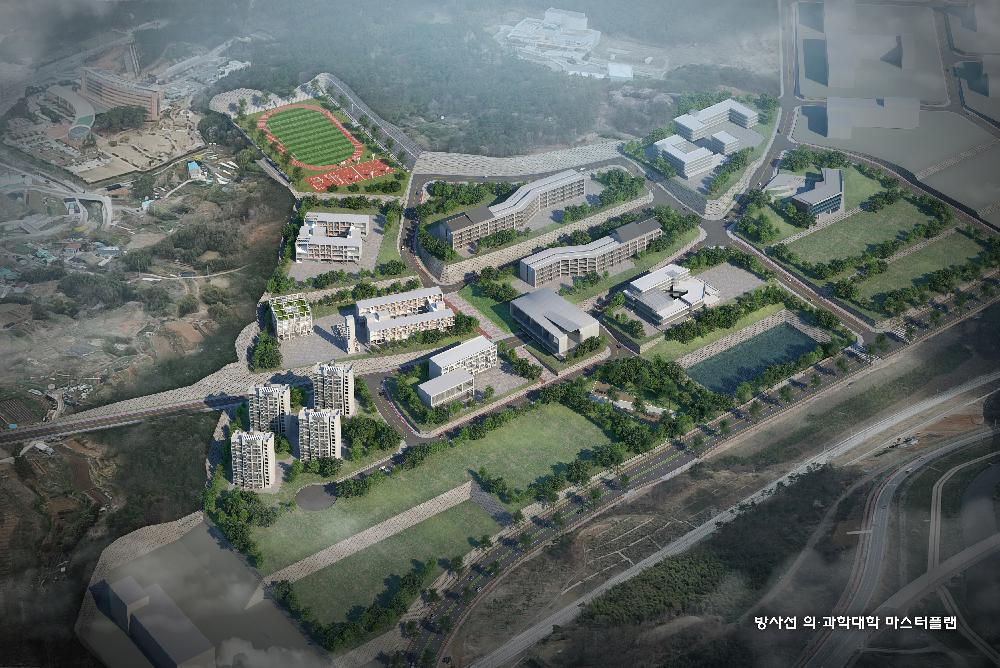Touching Tomorrow atPukyong National University
NEW BEGINNING, NEW INSPIRATION
Pukyong Today List
| PKNU starts out in the establishment of a medical college | |||
| WRITER | Department of External Cooperation | WRITE DAY | 2020-06-19 |
| COUNT | 273 | ||
| PKNU starts out in the establishment of a medical college | |||||
 |
Department of External Cooperation |  |
2020-06-19 |  |
273 |
|
PKNU promotes the establishment of the Gijang Campus, where the College of Radiology & Medical will be a key role Pukyong National University recently opened a TF & working committee for the establishment of a College of Radiology & Medical, and decided to establish a world-class convergence and complex campus of over 231,404.959㎡, including a radiology medical college, in the ’Southeastern Radiology and Science Industrial Complex (hereinafter referred to as the Medical Science Complex)’ in Jangan-eup, Gijang-gun, Busan by 2030. PKNU builds up a new College of Medicine & Science by 2022, creates a campus for 2,000 students by 2030 By 2022, Pukyong National University will establish the Radiological & Medical College as the 1st stage of the project, and based on this, the Graduate School of Radiology & Medical will be established for basic and applied research in radio-therapeutics for the 2nd stage. Since the establishment of the College of Pharmacy is included in the 2nd stage of this project, it is expected that if the 1st and 2nd stage projects finishes up, it will lead the Gijang Campus to the best radio-therapeutics in Northeast Asia linked with the existing Dongnam Institute of Radiological & Medical Sciences and the Medical Heavy lon Accelerator called as the dream cancer treatment device. Next, Pukyong National University plans to establish and expand departments related to fusion · convergence and engineering related to the center for power semiconductor commercialization and fusion R&D infrastructure facilities for isotope, including advanced research reactor in the medical science complex for 3rd stage from 2026 to 2030. Through this, Pukyong National University plans to create a world-class fusion · convergence type campus. Upon completion of the plan, a new campus with 2,000 students and 500 professors and staff will be built in Jangan-eup, Gijang-gun. Leap into the advanced radiology science cluster by linking the Gijang Medical Science Complex with the Gijang Campus of Pukyong National University Currently, in the medical science complex, the Medical Heavy lon Accelerator (266.6 billion won), which is a core facility of radiology and radiation science, advanced research reactor (438.9 billion won), a power semiconductor commercialization center (194 billion won), a fusion R&D infrastructure facilities for isotope (30.3 billion won), and Dongnam Institute of Radiological & Medical Sciences with 300 beds (174.9 billion won), total of 1.98 trillion won will be invested in the construction of five major facilities, and it is expected that this medical science complex will become a world-class radiological science cluster when it is connected to the Pukyong National University Gijang Campus. Accordingly, in order to promote the College of Radiological & Medical and the Gijang Campus of Pukyong National University, the Busan Metropolitan City will enter into a joint MOU with Pukyong National University and Gijang-gun on the 24th, and will begin to actively engage in activities of attracting for the College of Radiological & Medical. Prior to this, Gijang-gun signed a letter of intent related to the free provision of educational facility land (111,437㎡) in the medical science complex in February, subsequently, if more campus sites are needed, the city planning facility will be requested to be changed at the end of this month to utilize adjacent industrial land (140,000㎡). The full ranges of support from Busan City and Gijang-gun for the establishment of Pukyong National University’s Radiological & Medical College Busan City expects Busan to leap forward as a ’cancer treatment hub’ in Northeast Asia by securing professional manpower associated with medical schools and heavy ion accelerators once Radiological & Medical College is established which is the 1st stage project of Pukyong National University. In addition, the establishment of the 2nd stage, the Graduate School of Radiology and Medical Sciences, and the College of Medicine, will provide the foundation for a complex of high-tech radiation medical complexes comparable to the high-tech medical complexes of Daegu and Osong. When the 3rd stage fusion & convergence campus is completed, it will be possible to secure a future convergence radiology science cluster in which ’Industry, academia, research, hospital’ are linked. When establishing a medical school, a budget of KRW 500 billion is required, such as investing more than 300 billion won to build an affiliated hospital, but the College of Radiology and Medical of Pukyong National University can utilize the Dongnam Institute of Radiological & Medical Sciences located in the same site as an affiliated hospital, and the land is provided free of charge by Gijang-gun. Therefore, based on the minimum recruitment unit (40 students) of the medical school, the national budget costs 33.2 billion won for the construction fee for dormitories, recruitment of faculty which is 1/10 of the cost of establishing a medical school in another national university. <Pukyong Today> |
